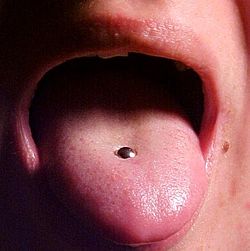Tongue: Difference between revisions
Tony Sidaway (talk | contribs) mNo edit summary |
|||
| Line 43: | Line 43: | ||
[[category:gustatory system]] |
[[category:gustatory system]] |
||
[[Category:Mouth]] |
|||
[[cy:Tafod]] |
[[cy:Tafod]] |
||
[[de:Zunge]] |
[[de:Zunge]] |
||
Revision as of 06:53, 17 January 2005
- Alternative meaning: Tongue, Highland

The tongue is the large bundle of muscles on the floor of the mouth that manipulates food for chewing and swallowing. It is one of the organs of taste. Much of the surface of the tongue is covered in taste buds. The tongue assists in forming the sounds of speech, and also plays a major role in the tongue kiss and in oral sex.
The word tongue can be used as a synonym for language, e.g. as in the phrase mother tongue.
It is also observed diagnostically in traditional Chinese medicine.
The tongue is made mainly of skeletal muscle and is attached to the hyoid bone, mandible and the styloid processes of the temporal bone.
The muscles that attach the tongue are the extrinsic muscles of the tongue. Inside the tongue, there are four pairs of intrinsic muscles that can alter the shape of the tongue for talking and swallowing.
The dorsum (top side) of the tongue can be divided into two parts, an oral part that lies mostly in the mouth, and a pharyngeal part (posterior third of the tongue) which faces backwards to the oropharynx. The two parts are separated by a V-shaped groove, the sulcus terminalis (or terminal sulcus).
The dorsal side of the anterior two-thirds (oral part) of the tongue is covered in taste buds (or papillae), and the tongue appears velvety and pink. There are four types of taste buds: filiform, fungiform, vallate and foliate. At the back of the oral part of the tongue there are 3-14 vallate papillae arranged in a V-shape in front of the sulcus terminalis.
There are no lingual papillae on the underside of the tongue. It is covered with a smooth mucous membrane, with a fold (the lingual frenulum) in the centre.
The upper side of the posterior tongue (pharyngeal part) has no visible taste buds, but it is bumpy because of the lymphatic follicles lying underneath. These follicles are known as the lingual tonsil.
Things related to the tongue are often called lingual which comes from the Latin word, or glossal which comes from the Greek word for tongue.
Extrinsic muscles of the tongue
There are four pairs of extrinsic muscles that act to move the tongue, and these are attached to various bones of the head and neck.
- Genioglossus - this muscle comes from the genial tubercule of the mandible (lower jaw bone), and comprises most of the bulk of the tongue.
- Hyoglossus - attached to the hyoid bone, ...
- Styloglossus - comes from the styloid process of the temporal bone
- Palatoglossus - is a muscle which connects the soft palate to the tongue, it forms the bulk of the anterior of two arches that delineate the oral cavity from the oropharynx.
Intrinsic muscles of the tongue
Four pairs of muscles run through the...
